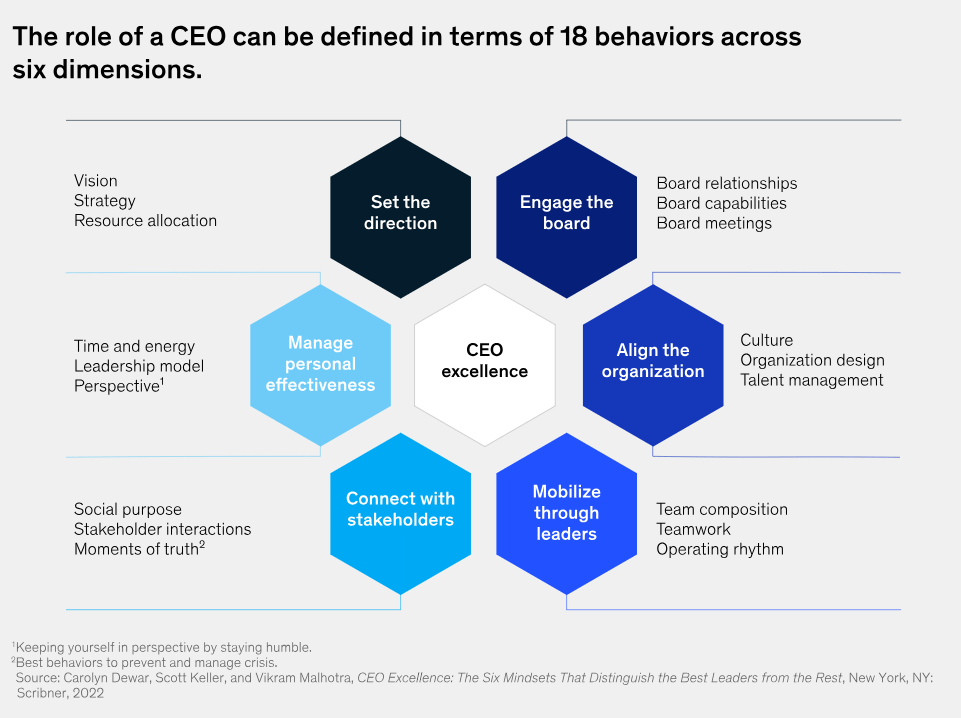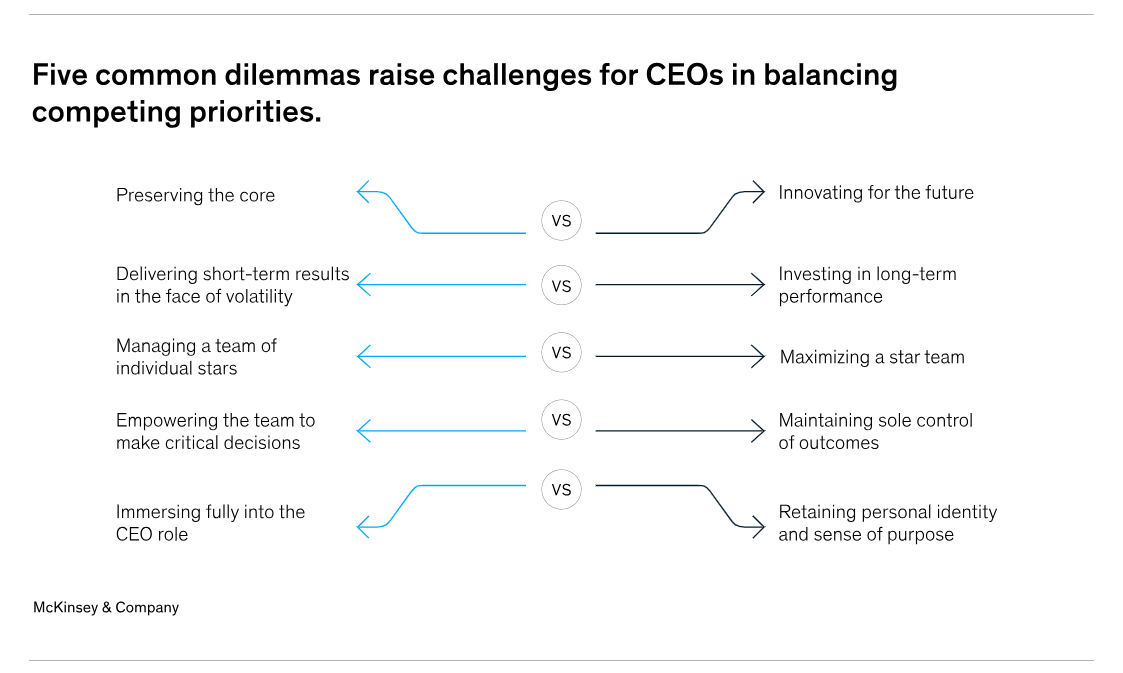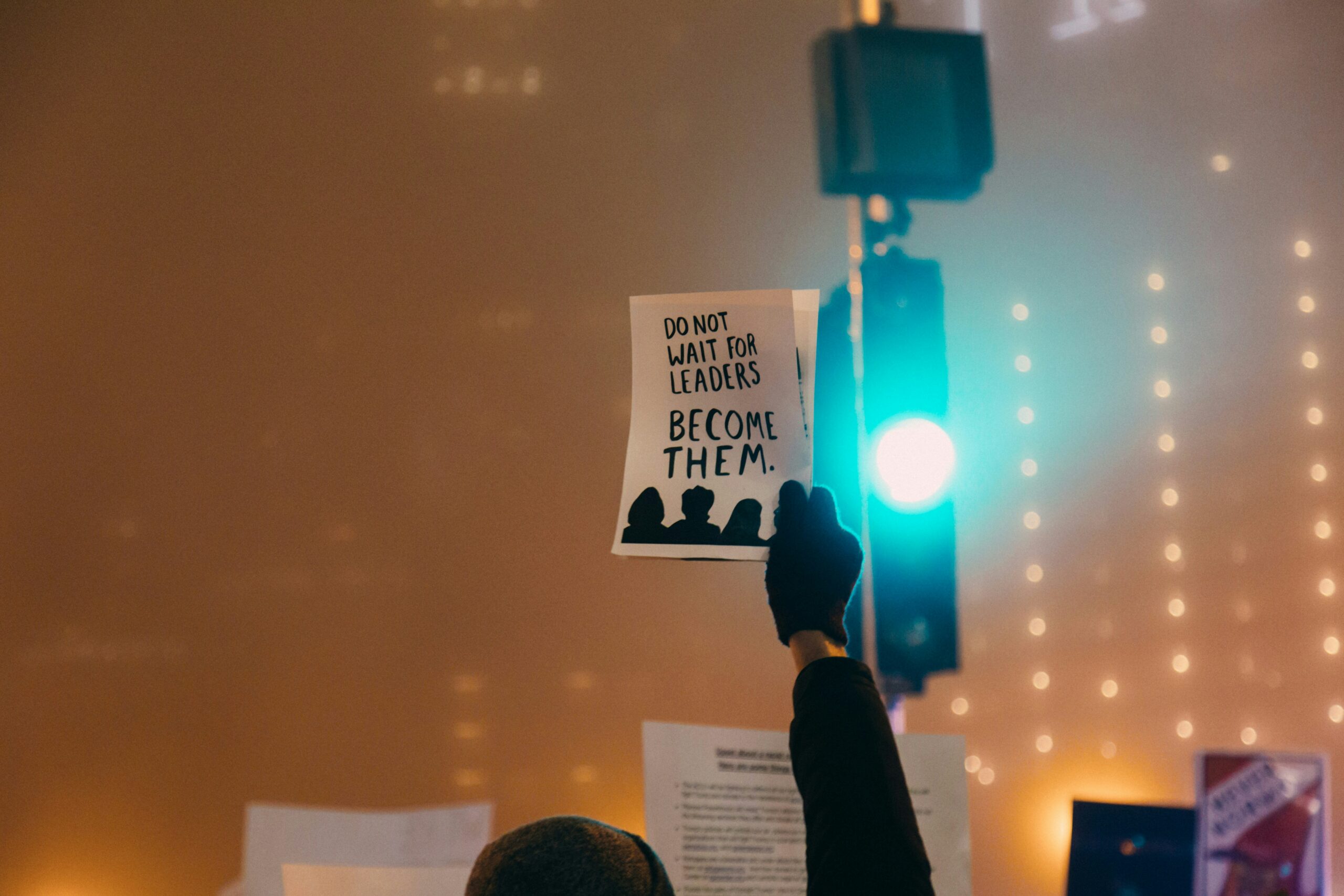This article consolidates insights from around 100 senior leaders on five common dilemmas that complicate their ability to lead in the face of competing priorities.
This article is a collaborative effort by Gautam Kumra, Joydeep Sengupta, and Mukund Sridhar, with Janice Koh and Jennifer Chiang, representing views from the McKinsey Center for CEO Excellence.
For many leaders, assuming the role of CEO is a key career goal and the culmination of decades of hard work. The CEO role is also among the most challenging and demanding positions in any organisation—particularly during times of uncertainty and upheaval.
About 100 CEOs have passed through the McKinsey Center for CEO Excellence (MCCE) leadership program since it launched in mid-2022 (for more information on the MCCE, see accordian below, “About the McKinsey Center for CEO Excellence”). These senior leaders—representing companies from Africa, Asia, Europe, and the Middle East—have openly shared their triumphs and struggles with us. In a previous article, we shared provisional results from our proprietary CEO Excellence Assessment Tool (CEAT), a self-assessment survey designed to capture CEOs’ aspirations and behaviors.[1]
This article complements that quantitative data with rich, qualitative insights gleaned from our discussions with MCCE participants about the inevitable moments of uncertainty they face during their tenures.[2] Often, these uncertainties are rooted in one or more of five common dilemmas. Each dilemma concerns a time when CEOs are required to strike a balance between multiple desirable outcomes, which may be—or appear to be—incompatible. How, for example, do CEOs walk the line between preserving the core of their business and innovating for the future? How can they deliver short-term results while investing in long-term organisational health? How do they preserve a personal identity while fully immersing themselves in their role?
By illuminating lessons learned by CEOs during these difficult moments, we hope to shed light on a seldom-discussed side of the CEO experience. The CEO journey can be lonely, and even the most successful CEOs experience moments of doubt and vulnerability. We hope this article sparks an open conversation about the many overlapping challenges facing today’s CEOs as well as the tactics and structures they can use to bolster their performance at work and maintain a sense of personal well-being.
The McKinsey Center for CEO Excellence (MCCE) is McKinsey’s dedicated offering for CEO development. The MCCE is anchored on the six dimensions described in CEO Excellence: The Six Mindsets That Distinguish The Best Leaders From The Rest (Scribner, March 2022), written by McKinsey senior partners Carolyn Dewar, Scott Keller, and Vikram Malhotra. These six dimensions—setting the direction, engaging with the board, aligning the organization, mobilizing through leaders, connecting with stakeholders, and managing personal effectiveness—are further broken down into 18 behaviors (exhibit).
Exhibit

The research underpinning the book is based on more than 20 years’ worth of data on 7,800 CEOs from 3,500 public companies across 70 countries and 24 industries.[1]
The flagship MCCE journey involves a nine-month CEO Excellence program, tailored to help CEOs elevate their performance and reach their full potential. Each MCCE cohort brings together an exclusive group of CEOs, carefully curated from diverse industries and regions, and offers an unparalleled opportunity for executives to learn from experienced senior CEOs, engage with like-minded peers, and obtain feedback on their leadership style and behaviors.
Five Dilemmas for Today’s CEOs
CEOs make many decisions—large and small—every day across a broad range of issues. This frequently entails optimising multiple possible outcomes and juggling difficult trade-offs. Managing these decisions is central to the CEO role, which “sits at the intersection of all contradictions.”[3] Our conversations with CEOs suggest that these decision moments most often involve one (or more) of five key dilemmas (exhibit).
Exhibit

Dilemma 1: Preserving the Core While Innovating for the Future
Preserving the core of the business is paramount for most CEOs, because of a desire to respect the history and business value of established brands. Klaus Kleinfeld, former chair and CEO of Arconic and former president and CEO of Siemens, said, “When a company is over a hundred years old, a lot of people have done a lot of things right. I’m standing on the shoulders of giants. People who have been there before me made the decisions that benefited me.” At the same time, the CEOs we spoke to are aware of the fast-changing context in which they operate—especially in Asia—and the need to continually innovate to future-proof their organisations and maintain their market positions.
Balancing these two important aims can be particularly challenging for second- and third-generation CEOs running family businesses, who wish to preserve the family legacy while necessarily innovating for the future. For example, when the CEO of a family business in Southeast Asia sought to transform the business to avoid losing market share, one of his biggest hurdles was gaining buy-in within the family. He was eventually able to bring all stakeholders along by ensuring that his top team—a careful balance between the “old guard” and new professional hires—co-owned the company’s new mission statement. Gaining alignment required many iterations and numerous town halls to broadly communicate the updated vision. The result? A more customer-centric and data-driven organisation, underpinned by traditional family values.
Managing this dilemma can also be challenging for publicly listed companies. One manufacturing company CEO had to allocate resources between two businesses in his company’s portfolio. The first was a huge revenue driver but with shrinking demand. The second business was in a fast-growing segment but required massive investment and was losing money; gaining a foothold in the market required an aggressive pivot, including retraining or replacing existing talent.
Gail Kelly, former CEO of the Westpac Group, stressed that innovating and preserving the core are not opposing goals. “The core is the heart of the business,” she said, “and businesses should keep innovating in the core to deliver and sustain performance, while simultaneously building new businesses. Preserving the core requires continued innovation.” A CEO can pursue thoughtful and strategic innovation to grow the company without taking excessive risks, while honoring its history and preserving assets, value, and a legacy of success.
Dilemma 2: Delivering Short-Term Results While Investing in Long-Term Performance
CEOs want to ensure they are “doing right by the company” in the long term and making the difficult decisions that will create sustainable value. At the same time, however, they are constantly subject to contradicting views from the board and other stakeholders and are pressured to boost short-term value in ways that may not position the business for long-term success.
A focus on short-term success can be particularly alluring during challenging times. One CEO led his company through a far-reaching company transformation, resulting in a record-breaking 2022, but then faced a broad range of industry-wide difficulties in 2023. It was “difficult to stay on track with the transformation,” he told us. “I know what I’m doing is right, but the results are not coming through.”
Optimising for the short term can be a risky strategy, too. Peter Olson, former CEO of Random House, regretted not thinking more about the process of merging two publishing houses: “I focused too much on making short-term targets and not enough on culture and talent development.”
Where short- and long-term goals compete, CEOs that opt to steer a steady long-term course may be positioned to withstand other pressures. Building and maintaining wider support in the chosen long-term strategy can help CEOs navigate pressure.
In many cases, however, short- and long-term goals can be distinct or even self-reinforcing. As Gail Kelly put it, CEOs need both a short-term and a long-term focus: “CEOs need to have a portfolio of projects, some of which will deliver in the short run, and others of which will deliver over the longer term,” she said. Kelly argued that clear and transparent communication with investors and the board is critical throughout the process. CEOs need to avoid over-promising and under-delivering and be up-front if a project is taking longer than expected or needs more investment.
Dilemma 3: Managing a Team of Individual Stars Versus Maximising Collective Performance
The CEOs we spoke to wanted to support each individual on their senior leadership team in performing at the top of their potential and getting opportunities to build and exhibit their distinctive strengths. At the same time, CEOs need to optimise the performance of the team, which may require them to focus on not only people or relationships but also skill sets.
A number of CEOs said they had found it difficult to manage individualistic star performers who consistently delivered great results but did not work well with others on the top team. In hindsight, several CEOs cited not dealing with a toxic high performer fast enough as one of their top regrets. The friction and loss of cohesion in the top team often led to serious long-term issues, including the loss of valued team members from the company.
Gail Kelly noted that CEOs sometimes retain an individual for too long instead of admitting that they made a poor choice; however, “if the person is a poor cultural fit, it is better for both the individual concerned and for the organisation that the CEO makes the call early.”
A number of CEOs, particularly those whose companies are undergoing transformation, also noted a related dilemma: getting the balance right between long-tenured, loyal employees and new employees who have the skill sets necessary to transform the company but may not fully embrace the company’s values.
Nazir Razak, founding partner of Ikhlas Capital and former chair and CEO of CIMB Group, stressed that CEOs need to effectively manage both types of employees: “Good management starts with who is a ‘missionary’ and who is a ‘mercenary,’ and management and compensation structures will often need to vary. When the business is going well, the mercenary may be the easiest person to put in the role, but you need to have a clear succession plan as you never know when they will leave.”
For Nazir Razak, the most difficult challenge is managing toxic superstars who may have the full trust of the CEO. He has managed this challenge by working with these individuals to see if change was possible and—if not—going out of his way to find the departing employee a new role outside the company. “How you let go of the individual is of utmost importance,” he said. “Everyone in the company is watching your actions as a CEO.” Klaus Kleinfeld believes in a strong selection process, in which performance and values are evaluated at the same time. Once a person has been chosen, he welcomes them with trust. He strongly believes that a sustainable high-performance culture that thrives on improvement and innovation grows best in an environment based on trust and values. However, anyone who significantly compromises the organisation’s values must be let go even if they are a star performer—and ideally, in a very visible way so the organisation gets the message.
Dilemma 4: Empowering Others While Maintaining Control of Outcomes
Delegation is a vital skill for CEOs; empowering others is important for overall company performance and for building and developing leaders. At the same time, CEOs are ultimately accountable for company results and may, therefore, be reluctant to surrender control.
This balancing act can be particularly challenging for new CEOs, who may need to transition from an operator mindset, which was likely required in their previous role, to an orchestrator approach. Even for longer-tenured CEOs, deciding how and where to cede control can be an ongoing challenge. One experienced banking CEO in Southeast Asia admitted he still has trouble stepping away because of concerns that his team might make a mistake. As a result, he regularly stays late in the office to check detailed reports for possible errors.
Balancing delegation with accountability is an ongoing challenge for CEOs. They can help improve the company by creating a structure that allows their teams to fail and learn in a relatively low-risk environment while ensuring appropriate degrees of supervision and oversight.
In addition, assembling a group of trusted direct reports can help CEOs to delegate day-to-day responsibilities and decisions, freeing them up to focus on the big picture. Meanwhile, delegation often improves company performance, as Peter Olson makes clear: “CEOs may think that only they can make the best decisions about anything and everything, but in fact, if you have the right team, each of them will know their area—and make the right decisions—far better than the CEO.”
Even with judicious hiring, role clarity, and appropriate safeguards, organisations make mistakes—a reality that CEOs need to accept. Peter Olson said one of his major challenges as a CEO was “learning to drop the perfectionism and focus on the 95 percent of work that is done well, and not on the other 5 percent.”
CEOs can decide where to retain control and where to delegate based on the specific context. Nazir Razak stressed that CEOs will need to evolve their management style based on the needs of the company: “A period of transformation may call for a more authoritative approach, after which the CEO could relinquish a degree of control,” he said. “Smart CEOs frequently look at themselves in the mirror to see if they are still the right person to manage that business.”
Dilemma 5: Becoming Fully Immersed in the CEO Role While Retaining Personal Identity and Sense of Purpose
Most leaders want to perform at the highest possible level, which requires an intense degree of focus, commitment, and resilience. This was Peter Olson’s experience: “When I took over the job, the job took over my life,” he said. At the same time, CEOs want to have some sort of a personal life, including maintaining and building personal relationships and pursuing other interests. CEOs we spoke to found that striking this balance was a chronic challenge. This may be especially true in Asia, where rates of employee burnout are significantly higher than global averages.[4]
But many experienced CEOs said that at some point, they had realised they needed to find a sustainable balance to excel in their role. As Gail Kelly said, “It’s OK to have a busy or challenging period, but that can’t be your entire CEO career. You need to live your whole life, not just the business part of your life.” CEOs used different strategies to attain this balance. One said he carves out windows of time when he can be fully present at home, rather than having time at home with constant distractions. Many other CEOs expressed the importance of staying “in the moment,” engaging 100 percent in whatever they are doing.
Tips and tricks aside, the CEOs who said they had achieved a balance shared a common attribute: they had found their North Star. Having a sense of mission enabled them to maintain balance, clarity, and purpose. A CEO of a construction company shared his desire to build infrastructure that could support his country’s progress, both economically and socially. Similarly, a retail CEO spoke passionately about wanting to develop the next generation of talent in her country.
Having an overarching mission helps free CEOs from the sense that their job is simply to deliver against a constant stream of KPIs. “CEOs who have found greater balance are those who value the journey more than the destination,” said Fabrice Desmarescaux, leader of Aberkyn Asia and a CEO leadership coach at McKinsey.[5] “Chasing targets, whether it’s a share price or a market share, creates a sense of permanent dissatisfaction and the illusion that we’ll be happy when we reach our goal. Nothing could be further from the truth.”
Once CEOs are clear on their mission, they often find they have considerable capacity to set, or reframe, targets and KPIs. One CEO spent nine months broadening her company’s initiatives and targets to ensure alignment between her mission and that of the company. She emerged from that journey confident that the new set of KPIs made sense not only for the company but also for society, the environment, and her employees.
Finally, it can be hard for CEOs to bring their full personal identity, values, and purpose to the office rather than conform to the stereotypical notion of a CEO, but full immersion in the role calls for doing exactly that. As Fabrice Desmarescaux said, “The very worst way to lose yourself is to lose sight of your values. Under serious pressure to perform, CEOs can be tempted to cut corners or to adopt legal but unethical practices. This is a slippery slope.” Gail Kelly argued that bringing your complete self to work—and being open about doing so—can be beneficial: “Sharing aspects of your life broadly creates deeper relationships with your stakeholders because they see you as someone they can relate to.”
Important Takeaways from Interviewed Leaders
CEOs are generally dealing with some or all of the above dilemmas simultaneously. A CEO may, for example, be trying to modernise a business while also seeking to empower a micromanaged team or refocus difficult personalities—all while striving to maintain a balanced, purpose-driven life.
The following takeaways may help CEOs and aspiring leaders navigate the inherent challenges of their roles.
- Embrace a ‘both/and’ rather than an ‘either/or’ mindset. Although making trade-offs is fundamental to the CEO role, two (or more) competing outcomes or qualities can actually be compatible—or even complementary. When faced with a difficult trade-off, CEOs should resist the temptation to choose one side over the other. Instead, they should strive to transcend polarities and find a new solution space that satisfies both sides of the trade-off. In this way, polarities can become opportunities. This requires a willingness to be flexible, creative, and transparent in communication, as well as a commitment to continuous learning and improvement. Ultimately, embracing trade-offs can help CEOs build trust, resilience, and sustainable success for their organisations.
- Find your support network and allow yourself to be vulnerable. Leading a company can be a lonely endeavor. CEOs need to ensure they have systems in place to get the support they need. A network of peer CEOs may be a particularly useful source of advice and encouragement. These networks can be formal—developed, perhaps, through training programs or communities of interest—or informal. Crucially, the network must provide a safe space for openness, discussion, and sharing. O. P. Bhatt, former chairman of State Bank of India, counseled, “Vulnerability is sometimes mistaken as weakness, but I think it is a strength because it gives you awareness and, when done with sensitivity, can bring people together in a very positive way.”
- Continually reassess your priorities and keep an open mind. For Klaus Kleinfeld, a North Star can shift substantially over the course of a lifetime but “is a reflection of who you want to be at the end of your life. Having this clarity enables you to shape your own destiny, which is only partially defined by your career.” Peter Olson said that CEOs should be honest with themselves about what they find fulfilling and what tasks and activities they do and do not like, and they should regularly reassess whether their job meets those criteria. He argued, “If it does not, they should spend more time doing the things that bring them the most joy and excitement—their increased enthusiasm will also inspire the entire team.”
- Carve out regular time to reflect and reconnect with your mission. A sense of purposelessness and a misalignment between personal and company mission can have a detrimental effect on job satisfaction and performance. The day-to-day work of running a company can feel relentless, but carving out time to reflect on your personal mission and value to the company is vital to maximising your impact.
Many leaders will look back on their time as CEO as one of the high points of their career. Few other positions offer equivalent opportunities to meaningfully direct business building, talent development, and broader societal goals. However, even the most successful CEOs will experience moments of doubt and vulnerability. By leaving time for reflection during their tenure, CEOs can ensure they are staying true to their mission and create value on which the next leader can build.
About the author(s)
Gautam Kumra is chairman of McKinsey Asia and senior partner in McKinsey’s Singapore office, where Joydeep Sengupta and Mukund Sridhar are senior partners; Janice Koh is director of operations for the McKinsey Center for CEO Excellence (MCCE) in the Singapore office; and Jennifer Chiang is director of learning for the MCCE, based in the Hong Kong office.
The authors wish to thank Alexa Meng, Anna Wozniak, Fabrice Desmarescaux, Lynn Liu, and Salsafia Farulian for their contributions to this article.
The article was first published by McKinsey & Company.
Photo by Christina Morillo.

 5.0
5.0 




















